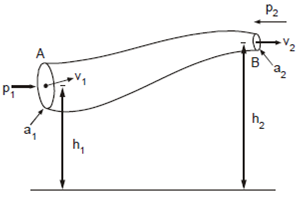Bernoulli's Equation:
To derive Bernoulli's equation, let us consider a tube AB in which a liquid is flowing as streamline flow (Figure). Let the density of the liquid is ρ and the heights of points A and B above ground level be h1 and h2 respectively. Let a1 and a2 be the areas of cross-sections of the tube at points A and B and p1 , p2 be the pressures and v1, v2 be the velocities of flow at these points respectively.
Since the flow of liquid is streamline and in view of the equation of continuity, the net result of liquid flow in a time interval δt is transfer of mass, say m, from point A to point B. The question is: How much work is completed on the liquid of mass m and what is the change in its kinetic energy when it is transferred from point A to point B?

Figure: Streamline Flow of Liquid through a Tube of Different Cross-sectional Areas at difficult Heights from the Ground Level
To find an answer to these questions, we required to
(a) Calculate the change in the kinetic energy of mass m of the liquid in moving from point A to B, and
(b) Compute the work done on the system (mass m of the liquid) by
(i) Pressure difference among points A and B, and
(ii) The gravity.